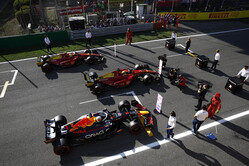


26/09/2022
NEWS STORY
 Veteran engineer, Alan Permane believes that the process of deciding the grid order following the allocation of penalties could be automated.
Veteran engineer, Alan Permane believes that the process of deciding the grid order following the allocation of penalties could be automated.
With teams strategically opting to take on new power units at Spa, where 7 drivers faced penalties, it was almost two hours before the FIA could confirm the provisional grid for the Belgian Grand Prix.
Two weeks later, with nine drivers penalised, teams, drivers and fans were left totally in the dark for almost four hours before the provisional grid was finally made available.
It was not a good look for the sport.
While the basics of the penalty system is easy enough to understand, it is the timing of when the penalties are awarded, the difference between a grid drop and starting from the back of the grid and the various penalties for different components that add to the confusion. Indeed, the only driver to start the Italian Grand Prix from the position in which he qualified was pole-man, Charles Leclerc.
In the case of drivers forced to start from the back of the grid, if there are more than one they remain at the back of the grid but in the order they qualified, hence at Monza, Carlos Sainz started 18th because he was 3rd fastest in qualifying, ahead of Lewis Hamilton (19th and 7th) and Valtteri Bottas (20th and 12th).
Veteran Alpine engineer believes it is crucial that the sport looks into the development of automatically processing the grid following the awarding of penalties.
"We have guidelines from 2020, and I think the grid was formed exactly how it stated in that guideline," says Permane, according to Speedcafe. "That guideline has been developed, was developed with F1 and the FIA, and has been applied consistently since then.
" I don't think there's any surprises in it," he continues, "but there might have been among people who didn't have the guideline, I guess. But I do agree that three and three-quarter hours is a bit long to wait for a grid.
"I think it would be relatively simple for them to publish it as the last car crosses the line, with the proviso it might change after scrutineering or whatever. They could plug all the known penalties into something, and it would be better for everybody."
The FIA, under its new president, has invested in a remote operations centre (ROC) at its Geneva headquarters to aid the race director in the wake of the Abu Dhabi debacle, Permane believes that this could, in time, lead to the development of a system to speed up the grid process.
"I'd imagine so but I'm not an expert," he says, when asked if a computer program could aid the process. "But you would know that the car that is in first, it's going to have a 10-place penalty, you have all of the information at the end of qualifying, and I'm sure they'll look at it.
"I don't quite know why it took so long," he admits, referring to Monza, "I guess they were double checking, triple checking everything.
"They're supposed to have a grid published four hours before the start of a race, so anything we get on a Saturday night is a bonus, and they publish a provisional grid.
"I get it for you guys (the media), it's important, and it's also important for us to start building our strategies and things like that."
It's also important for the fans, especially those new fans won over by the likes of Drive to Survive, fans of the digital age who expect everything to be instantly available.